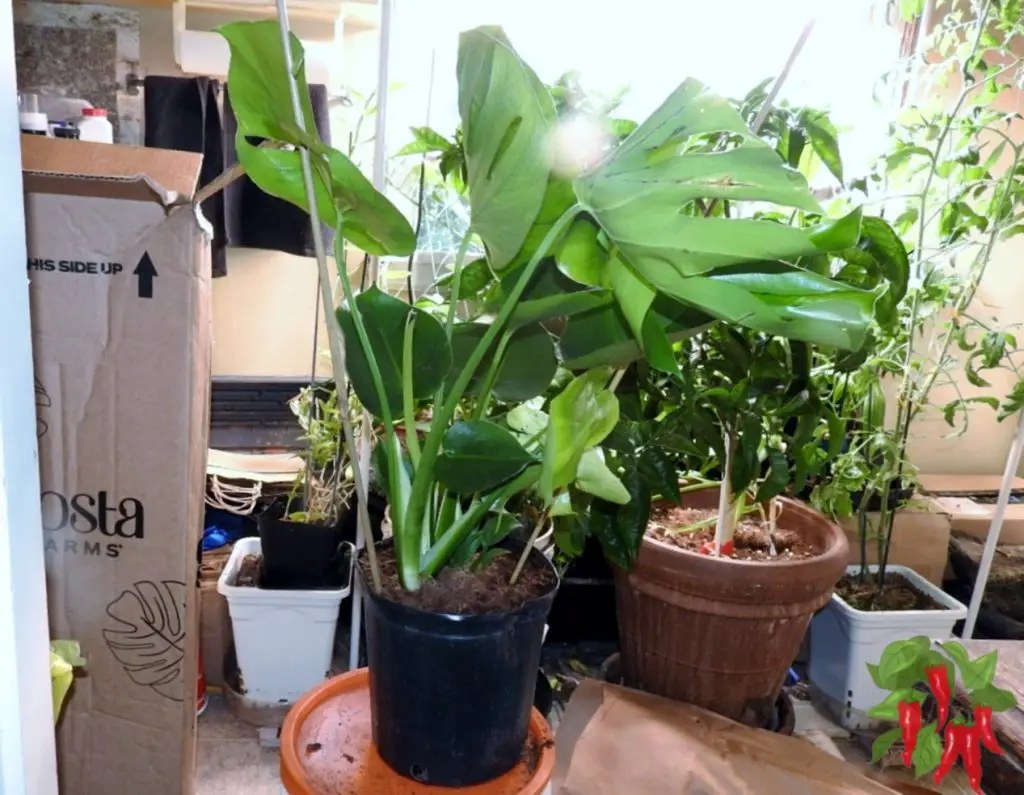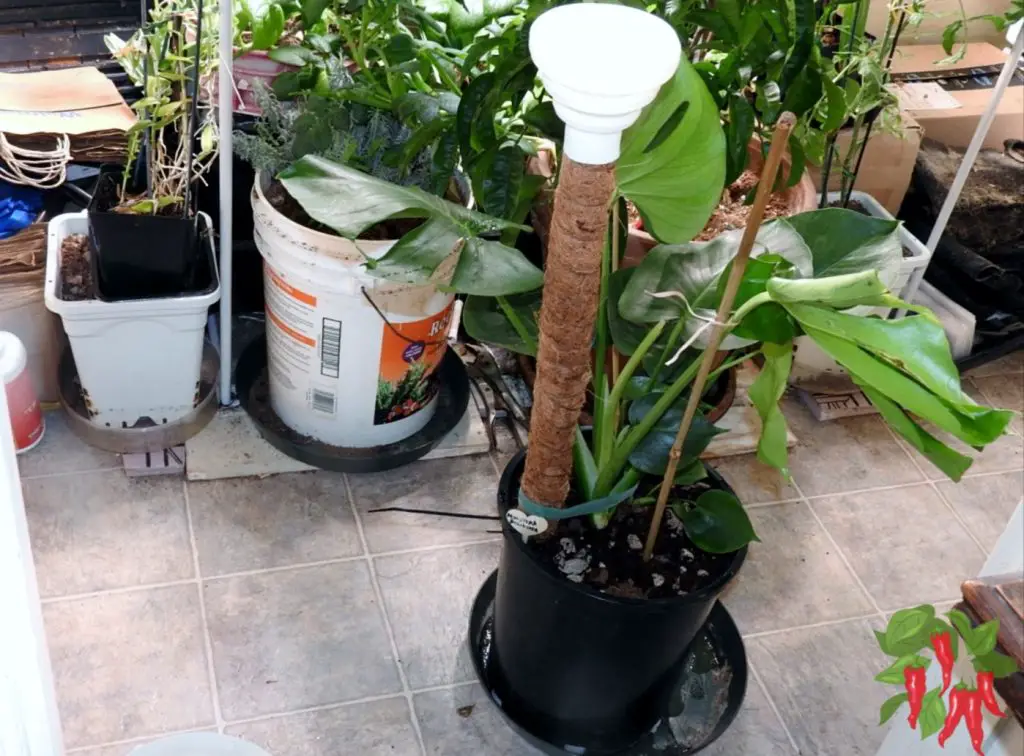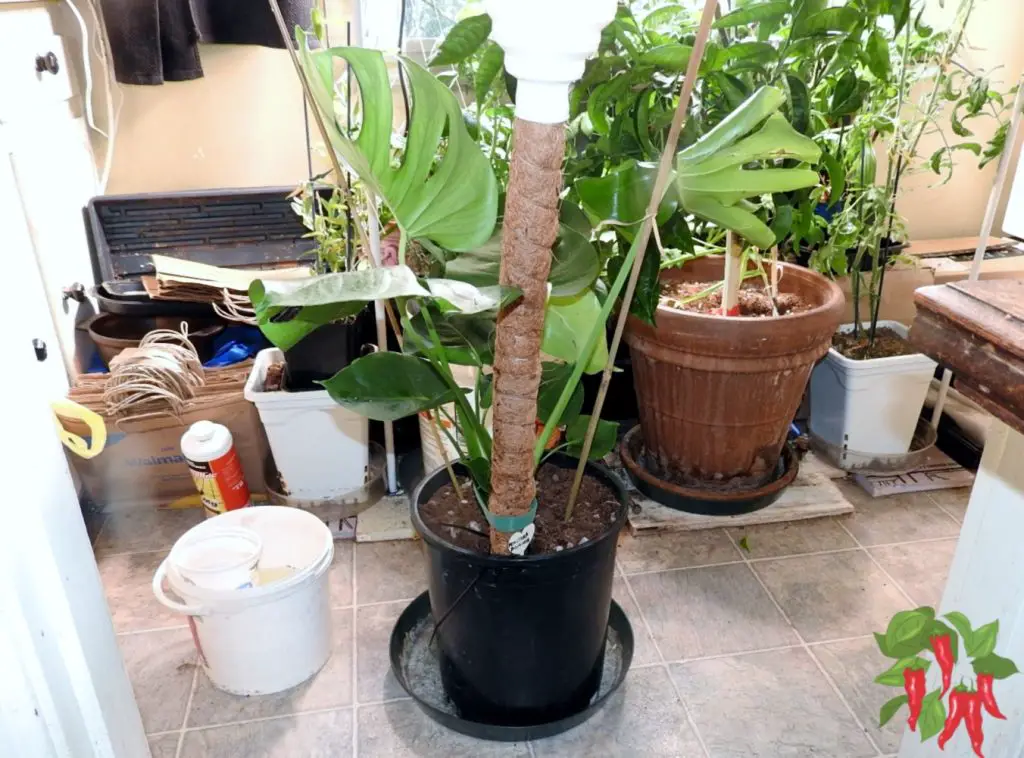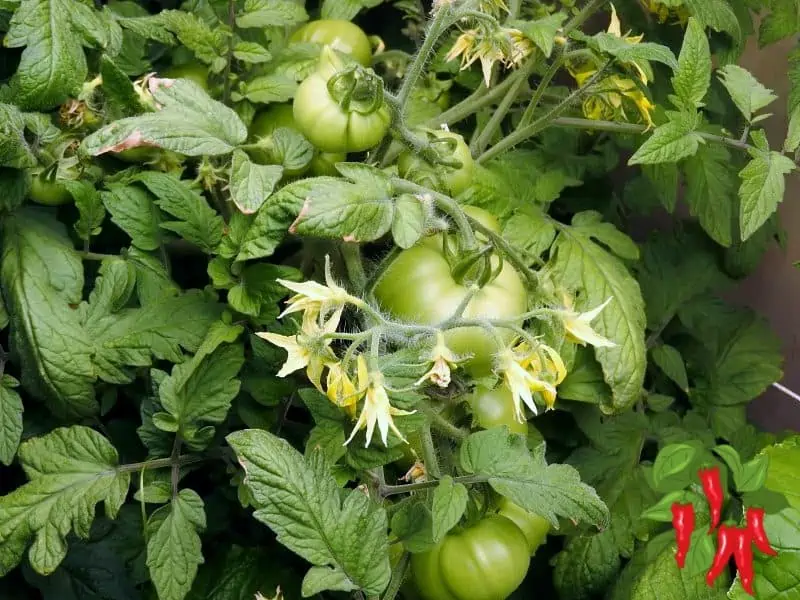This post may contain affiliate links. If you buy something from one of our links we may earn a commission. Thanks

Monstera deliciosa care indoors isn’t as tricky as you might think. These stunning tropical plants can thrive in your home with just a little know-how.
Ready to turn your space into a lush jungle paradise? Let’s dive into the secrets of keeping your Monstera happy and healthy!
Monstera deliciosa Care Key Takeaways
- Monstera deliciosa care involves bright, indirect light and moderate watering.
- Keep the soil moist but not soggy, and provide high humidity.
- Fertilize monthly during growing season and use a well-draining potting mix.
- Support climbing with a moss pole or trellis for larger leaves.
Monstera Deliciosa Swiss Cheese Plant Unboxing
What is Monstera deliciosa?
Monstera Swiss Cheese Plant, Easy to Grow Split Leaf Houseplant 2-3 Feet Tall
Monstera deliciosa, also known as the Swiss cheese plant, is a real showstopper in the world of houseplants.
With its big, glossy leaves full of unique holes and splits, it’s no wonder this tropical beauty has become a favorite for indoor gardeners everywhere.
Let’s get to know this plant a little better!
Description and origin
Monstera deliciosa hails from the lush rainforests of Central America. In its natural habitat, it climbs up tree trunks, reaching for the dappled sunlight filtering through the canopy.
Those famous holes in its leaves? They’re not just for looks – they help the plant handle strong winds and let light reach its lower leaves.
Historical significance
Folks have been bringing Monsteras indoors since the 1970s, when houseplants really started to take off.
Their dramatic leaves and easy-going nature made them an instant hit. Today, they’re more popular than ever, starring in countless Instagram posts and adding a touch of jungle vibes to homes around the world.
Monstera Indoor Plant Benefits
Who wouldn’t want a bit of tropical flair in their living room? Monstera deliciosa doesn’t just look good – it’s got some pretty cool benefits too. Let’s check out why having this leafy friend around is such a great idea.
Air purification
Like many houseplants, Monstera deliciosa is a natural air cleaner. It helps filter out some of the nasty stuff floating around in your indoor air, like formaldehyde and benzene. While it’s not going to replace your air purifier, every little bit helps, right?
Aesthetic appeal
Let’s face it – Monstera leaves are just plain cool. Those big, glossy green leaves with their unique holes and splits can turn any room into a tropical oasis. Whether you’re going for a jungle vibe or just want to add a touch of nature to your space, a Monstera is a great choice.
Mental health
There’s something about having plants around that just makes us feel good. Caring for a Monstera can be a relaxing hobby, giving you a little break from the daily grind. Plus, all that green is easy on the eyes and can help create a calm, peaceful atmosphere in your home.
Monstera Varieties
Think all Monsteras look the same? Think again! While Monstera deliciosa might be the most famous, there are plenty of other varieties out there to explore. Let’s take a quick tour of some popular and rare Monstera types.
Common types
- Monstera adansonii: Also called the Swiss cheese vine, this one has smaller leaves with more holes.
- Monstera obliqua: Similar to adansonii, but with even more holes – sometimes more hole than leaf!
- Monstera deliciosa ‘Thai Constellation’: A variegated variety with creamy white splotches on its leaves.
Rare varieties
- Monstera albo: This sought-after variety has stunning white variegation.
- Monstera dubia: A smaller, shingling variety that grows flat against surfaces.
Monstera Care for Beginners
New to the Monstera game? No worries! These plants are pretty forgiving, which makes them great for beginners. Here are some basic tips to get you started on your Monstera journey.
Basic care tips
- Light: Bright, indirect light is best. No direct sun, please!
- Water: Let the top inch or two of soil dry out between waterings.
- Humidity: They love it humid, so consider a pebble tray or humidifier.
- Soil: Use a well-draining potting mix to keep those roots happy.
Common mistakes to avoid
- Overwatering: This is the big one. More Monsteras die from too much water than too little.
- Too little light: They might survive in low light, but they won’t thrive.
- Ignoring pests: Keep an eye out for common houseplant pests like spider mites.
Monstera Climbing
In the wild, Monsteras are climbers. They use their aerial roots to scale up tree trunks in search of light. In your home, you can mimic this natural behavior to help your Monstera grow big and strong.


Support options
- Moss poles: These mimic tree trunks and provide a moist surface for aerial roots.
- Stakes: A simple wooden or bamboo stake can provide basic support.
- Trellises: Great for guiding your Monstera’s growth in a specific direction.
Training methods
- Gently tie stems to the support with soft plant ties.
- Guide aerial roots towards the pole or trellis.
- Be patient – it takes time for the plant to attach itself.
Monstera Deliciosa Care Indoors
Alright, let’s get into the nitty-gritty of Monstera deliciosa care indoors. These tropical beauties can adapt well to life inside, but they do have some specific needs.
Here’s what you need to know to keep your Monstera happy and healthy.
Light requirements: Monsteras love bright, indirect light. Think of the dappled sunlight they’d get in their natural rainforest home. A spot near a window with sheer curtains is perfect. Just keep them out of direct sunlight, which can scorch their leaves.
Humidity needs: Coming from tropical climates, Monsteras are big fans of humidity. While they can tolerate average home humidity, they’ll really thrive if you can bump it up a bit. Try grouping them with other plants, using a pebble tray, or running a humidifier nearby.
Temperature preferences: Good news – if you’re comfortable, your Monstera probably is too! They prefer temperatures between 65-85°F (18-29°C). Just keep them away from cold drafts and air conditioning vents, which can shock the plant.
How to Care for Monstera in Winter
Winter can be tough on tropical plants like Monsteras. The days are shorter, the air is drier, and temperatures can drop. But don’t worry – with a few adjustments, your Monstera can stay happy all winter long.
Adjusting care routines
- Water less frequently, as the plant’s growth slows down.
- Hold off on fertilizing until spring.
- Increase humidity if possible, as indoor heating can dry out the air.
Preventing cold damage
- Keep your Monstera away from cold windows and drafty doors.
- If you have drafty windows, consider moving the plant or using a thermal curtain.
- Maintain a steady temperature – sudden changes can stress the plant.
Monstera Deliciosa Care Watering
Watering can make or break your Monstera care game. These plants like their soil moist but not waterlogged. Let’s break down the best watering practices for your Monstera deliciosa.
Watering schedule:
There’s no one-size-fits-all schedule for watering Monsteras. Instead, check the soil regularly. When the top 1-2 inches feel dry, it’s time to water. In general, this might be every 1-2 weeks, but it can vary based on your home’s conditions.
Water quality:
Monsteras aren’t too picky about water, but they prefer it room temperature. If your tap water is heavily chlorinated, consider using filtered or distilled water.
Monstera Plant Care Light
Light is crucial for your Monstera’s growth and those iconic leaf splits. While they can tolerate lower light conditions, they won’t thrive. Let’s shed some light on the best practices for illuminating your Monstera.
Light intensity:
Bright, indirect light is the sweet spot for Monsteras. A north or east-facing window is often ideal. If you only have a south or west-facing window, use a sheer curtain to filter the intense afternoon sun.
Artificial lighting:
Don’t have a bright spot in your home? No problem! Monsteras can do well under grow lights. LED grow lights are energy-efficient and don’t produce much heat. Place them about 12-18 inches above your plant and keep them on for 12-14 hours a day.
Monstera Deliciosa Soil
The right soil can make a world of difference for your Monstera. These plants need a mix that holds some moisture but also drains well. Let’s dig into the best soil practices for your Monstera deliciosa.
Soil composition A good Monstera mix should be rich, well-draining, and slightly acidic. Here’s a simple recipe:
- 1 part potting soil
- 1 part perlite or pumice
- 1 part orchid bark or coconut coir
This mix provides good aeration and drainage while still holding enough moisture.
My preferred Monstera soil mix is coco coir and coarse perlite and I use 25-33% perlite. I want to avoid potting soil which is a peat-based medium and use coco coir which is a sustainable growth medium.
Repotting tips
- Repot your Monstera every 2-3 years, or when you see roots coming out of the drainage holes.
- Choose a pot that’s 2-3 inches larger in diameter than the current one.
- Spring is the best time to repot, as the plant is gearing up for active growth.
Monstera Fertilizer
Feeding your Monstera right can lead to bigger leaves, more splits, and overall healthier growth.
But like with watering, it’s all about finding the right balance. Here’s what you need to know about fertilizing your Monstera deliciosa.
Fertilizing Schedule
During the growing season (spring and summer), fertilize your Monstera once a month. Use a balanced, water-soluble fertilizer diluted to half strength.
In fall and winter, you can cut back to fertilizing every 6-8 weeks, or stop altogether if your plant isn’t actively growing.
Avoid Over Fertilization
Too much of a good thing can be harmful. Signs of over-fertilization include:
- Brown leaf tips
- Yellowing leaves
- Slow growth
- Salt buildup on the soil
If you suspect you’ve over-fertilized, flush the soil thoroughly with water to wash out excess nutrients.
Monstera Deliciosa Pruning
Pruning isn’t just about keeping your Monstera looking tidy – it’s also a great way to control its size and shape. Plus, those pruned pieces can become new plants! Let’s cut to the chase and talk pruning.
Pruning techniques
- Use clean, sharp scissors or pruning shears to avoid damaging the plant.
- Cut just above a leaf node (where a leaf attaches to the stem).
- Remove any yellow or damaged leaves at the base of the stem.
- To control size, cut back long vines to your desired length.
Using cuttings:
Don’t toss those cuttings! They’re perfect for propagation. Here’s a quick how-to:
- Cut a stem with at least one node and one leaf.
- Remove any lower leaves, leaving the node exposed.
- Place the cutting in water or moist soil.
- Wait for roots to develop (usually 2-3 weeks in water, 4-6 weeks in soil).
- Once roots are a few inches long, plant in soil.
Monstera Plant Propagation
One of the coolest things about Monsteras? You can turn one plant into many! Propagation is a fun way to expand your plant collection or share the love with friends. Let’s explore some ways to multiply your Monstera.
Propagation methods
- Water propagation: Place stem cuttings in water until roots develop.
- Soil propagation: Plant stem cuttings directly in moist potting mix.
- Air layering: Encourage roots to grow on the plant before cutting.
Rooting success tips
- Use a rooting hormone to speed up the process (optional but helpful).
- Keep cuttings in a warm, bright spot out of direct sunlight.
- Be patient – it can take several weeks for roots to develop.
- Once roots are a few inches long, plant in soil and care for it like a mature Monstera.
Monstera deliciosa Care Indoors FAQs
Got questions about Monstera care? You’re not alone! Here are some common queries about these fabulous plants.
Q: How much light does a monstera need?
A: Monsteras thrive in bright, indirect light. They can tolerate lower light, but growth may slow. Avoid direct sunlight, which can scorch the leaves.
Q: How do you care for a Monstera plant indoors?
A: Provide bright, indirect light, water when the top 1-2 inches of soil are dry, maintain high humidity, and fertilize monthly during the growing season.
Q: How do you keep Monstera deliciosa happy?
A: Give it plenty of indirect light, consistent watering, high humidity, and regular fertilizing. Also, provide support for climbing as it grows.
Q: Are Monstera deliciosa hard to care for?
A: Not at all! Monsteras are pretty forgiving and adaptable, making them great for beginners and experienced plant parents alike.
Q: What should you not do with Monstera?
A: Avoid overwatering, placing in direct sunlight, or letting it sit in cold drafts. Also, don’t forget to dust the leaves occasionally.
Q: Should I mist my Monstera?
A: While misting can increase humidity temporarily, it’s not the most effective method. A pebble tray or humidifier is better for consistent humidity.
Monstera deliciosa Care IndoorsConclusion
Whew! We’ve covered a lot of ground in our Monstera deliciosa care guide. These stunning plants might look exotic, but with a little know-how, they’re actually pretty easy to care for. Remember, the key is to mimic their natural tropical environment as best you can.
Here are the main points to keep in mind:
- Bright, indirect light is best
- Water when the top inch or two of soil is dry
- Keep humidity high
- Use a well-draining potting mix
- Support climbing for bigger leaves
- Fertilize regularly during the growing season
With these tips in your back pocket, you’re all set to grow a gorgeous, healthy Monstera. Before you know it, you’ll be showing off those big, holey leaves like a pro. Happy growing!
Monstera Key takeaways:
- Monsteras love bright, indirect light
- Water when soil is partly dry
- High humidity makes them happy
- Well-draining soil is crucial
- Support climbing for best growth
- Regular fertilizing during growing season
- Prune to control size and propagate
Remember, every plant is unique, so don’t be afraid to adjust your care routine as you get to know your Monstera. With a little patience and attention, you’ll be rewarded with a stunning, jungle-like addition to your home. Now go forth and grow those beautiful Monsteras!
Read more: Indoor Apartment Gardening: 15 Point Comprehensive Guide
Visit my Amazon Influencer Page for videos and gardening products Grow Your Own Garden








